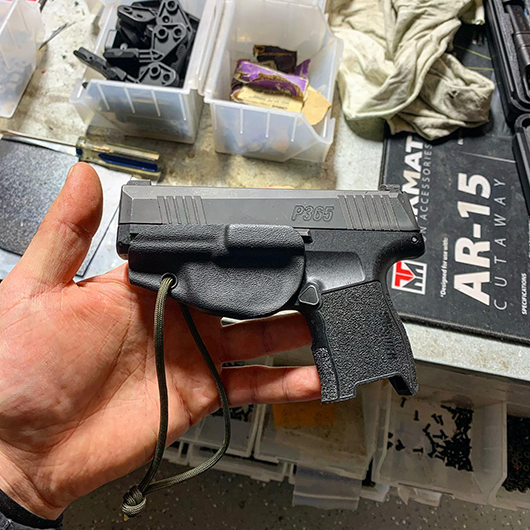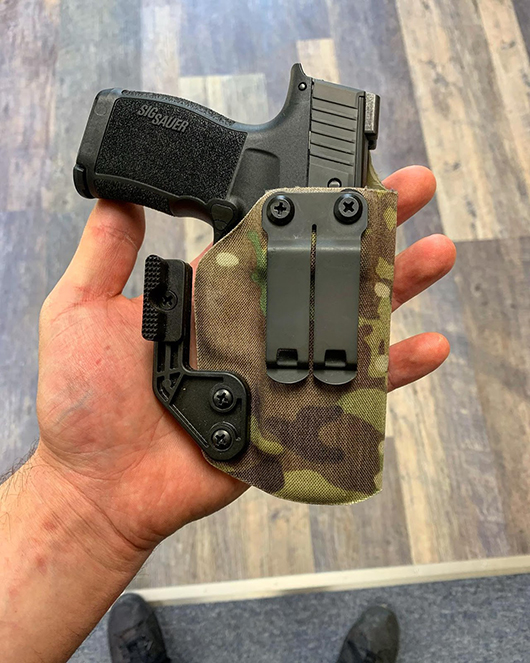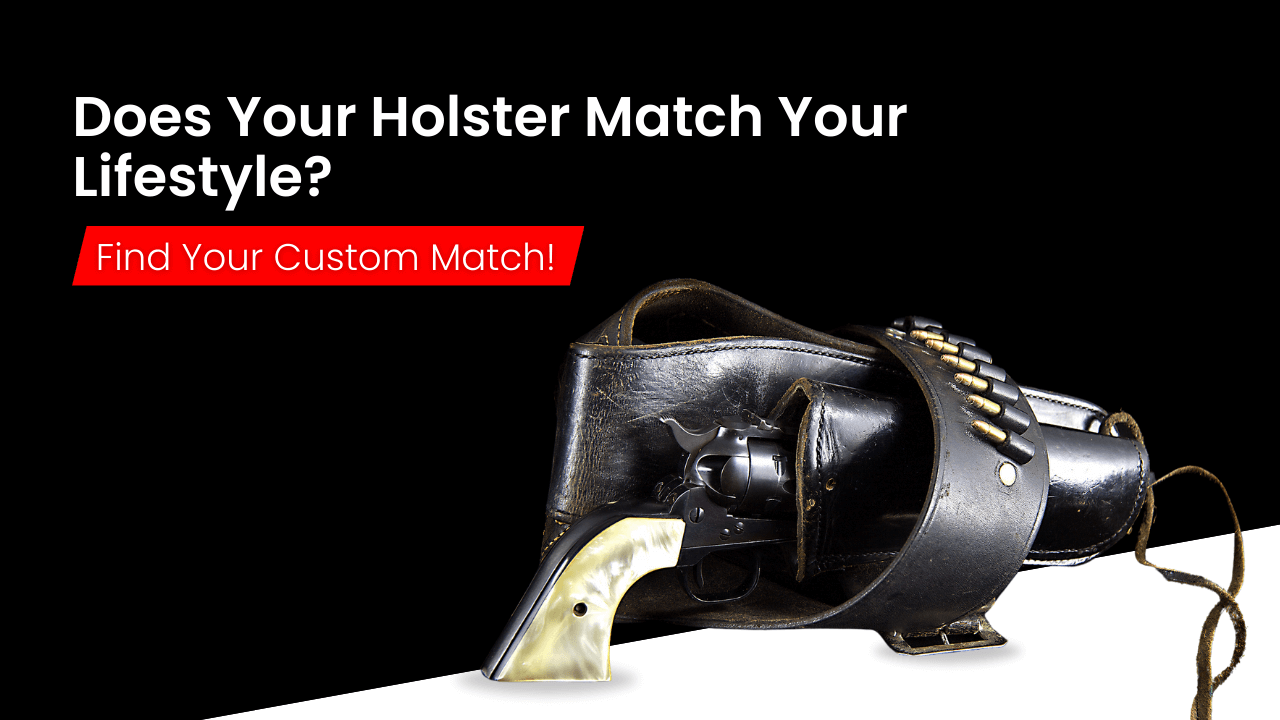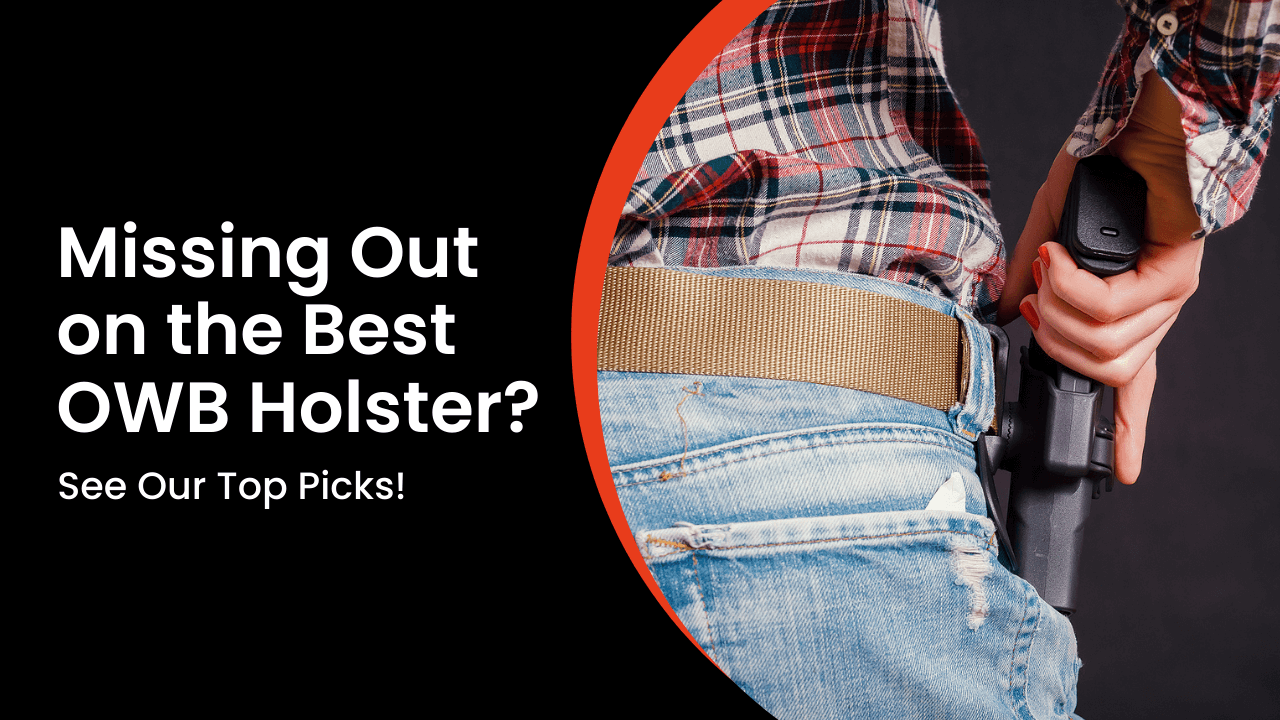The Best SIG P365XL IWB Holster
Jul 8th 2021

Ultra-compact handguns are ideal for concealed carry; however, reduced weight and gripping surface can compromise controllability, especially during rapid fire. The SIG Sauer P365XL is designed to combine the concealable qualities of the P365 Micro-Compact with the accuracy and control of a compact service pistol, striking a suitable balance.
You need a reliable holster to carry a reliable handgun, such as the P365. For carrying a compact handgun in a concealed holster, inside the waistband or IWB is one of the best positions. Find the best carry option to match.
SIG Sauer P365XL IWB Holster
The SIG Sauer P365 Micro-Compact is a semi-automatic, recoil-operated, striker-fired pistol designed to compete against the Glock 43 and other similarly sized, lightweight concealed-carry handguns. The XL variant is closer in size to the Glock 19.
The P365, in all its variants, has a minimalist design, an undercut trigger guard, and a relatively light and smooth trigger pull.
Best Waistband and Carry Positions
You can wear concealed-carry holsters in a variety of different positions. Some are better than others, but each position has its pros and cons. To find the best concealed carry position, you’ll need to experiment.
The two most common waistband-carry positions are strong side — i.e., between 3 and 5 o’clock for a right-handed shooter — and appendix (between 10 and 2 o’clock, depending on handedness). In strong side carry, also called hip carry, you wear the gun on or behind your dominant hip.
One of the primary advantages of strong side carry is that it allows you to face the target with your support side, increasing the distance between your weapon and the threat. Since you can acquire a full firing grip more discreetly, you can also retain the element of surprise more effectively. However, the strong side carry position can render a draw while seated in a vehicle difficult.
In appendix carry, you wear the gun in the front of your pants, at or beside your belt buckle/navel. This position allows for a quick-draw stroke and makes disarmament more difficult. This position is an excellent option for anyone who suffers from orthopedic injuries or diseases, particularly those that affect the shoulders and hips.
On the downside, some gun owners regard appendix carry as less safe due to the direction in which the gun’s muzzle is pointed. If you experience an unintentional discharge, your risk of serious injury or death is higher, as the bullet may hit your femoral artery.
Non-Waistband Holsters
Non-waistband holsters are generally less useful to the gun owner than wearing your gun inside or outside the waistband. Non-waistband holsters include shoulder, ankle holsters, pocket holsters, and leg holsters.
An ankle holster limits access and pocket holsters aren’t much better. A drop leg holster is unsuitable for concealed carry, and shoulder holsters are not as fast to draw from when standing.
Ride Height and Cant
Ride height refers to the height at which the holster rides on or inside the waistband relative to the centerline of the gun belt.
The three primary ride heights are high, mid, and low. The higher the ride height, the more space there is between the top of the belt and the front strap of the gun.
Cant refers to the degree to which the holster rotates forward or rearward relative to the belt centerline: This is also called the draw angle. The ideal cant depends on the position of your firearm on the waistband.
For example, right-handed strong side carry positions require a progressively more positive cant the closer the gun moves toward your lumbar spine. A positive cant, in which the butt of the weapon rises and the rear of the slide falls, increases your ability to acquire a full firing grip when you place the gun on or behind your right hip.
In a full firing grip, the webbing of your hand between your thumb and index finger should be at the top of the frame or beavertail, and your middle finger should contact the bottom of the trigger guard. Any holster you wear for self-defense should allow you to achieve this kind of hand placement on the gun before performing a full draw.
A positive cant of between 15 and 22.5 degrees is common. If you carry in the appendix position, which is typically between 12 and 2 o’clock for a right-handed shooter — i.e., forward of the right hip — a straight or neutral cant is preferable.
Ride height and cant are different values that complement each other. You’ll need to adjust them both to find the ideal balance regarding accessibility, comfort, and subtlety.
Holster Attachment
Our IWB holsters use a single 1.5-inch standard belt clip, although a 1.75-inch option is also available. Our pancake OWB holsters, on the other hand, use 1.5- and 1.75-inch belt loops or clips, giving you several attachment options. Always ensure the holster you select is compatible with your gun belt of choice.
Adjustable Retention
Retention describes the manner and extent to which the holster holds your firearm in place. This is one of the most critical characteristics of a holster. Secure retention prevents unauthorized access, such as by criminal assailants and children, and prevents your weapon from falling out.
Passive vs. active retention
There are two basic types of holster retention: Passive and active. In holsters that use passive retention, there is no separate locking mechanism. This allows for a relatively quick draw.
Instead, the holster uses a tight, often custom-molded fit to retain the weapon. That way, you can keep your firearm ready for deployment at a moment’s notice. It’s also the better choice for IWB concealed carry, as the weapon is close to your body and difficult to detect.
Active retention holsters have a separate locking or retention system that you must manually disengage to perform the draw stroke, such as a rotating hood or thumb-activated lever.
This active type of system increases security when carrying openly, especially in a duty holster. Active retention may also be better for certain vigorous outdoor activities.
Adjustable retention feature
Many Kydex holsters allow you to adjust the retention by tightening or loosening one or more screws. This adjustment alters the upward pressure you need for a more secure or faster draw.
At Incognito Concealment, we offer holsters that use both passive and active retention systems, so you can choose the design that best suits your preferred carry method.
Passive retention is an excellent feature for a properly concealed IWB carry holster.

Holster Safety
Every holster should have a fully covered trigger guard as standard. There are multiple reasons for this. When you place your strong hand on the grip of your weapon, there should be no risk of your index finger entering the trigger guard before you complete the draw stroke.
Consistent observance of the four rules of gun safety, including proper trigger discipline, is crucial; however, involuntary reactions are not uncommon under stress.
To minimize the risk of an unintentional discharge, the holster should encourage your finger to remain straight by providing full trigger coverage. The holster mouth should not collapse or deform when empty; you should be able to reholster your firearm with one hand. When your holster requires that you use your support hand to open the mouth, you risk covering your hand with the gun’s muzzle.
Durable Kydex Construction
Kydex offers a wide variety of holster design and construction benefits compared with other materials, such as nylon and leather. Kydex is waterproof, so it won’t deteriorate when wet, change its shape, or absorb moisture.
More rigid than a leather holster, Kydex won’t deform due to regular use, ensuring the mouth remains open. Leather also tends to be the more expensive option, whereas Kydex holsters are generally affordably priced.
Hybrid holsters attempt to combine the comfort and durability of both leather and Kydex. Unfortunately, hybrid holsters also tend to experience wear at different rates.
Sweat Shield
If your gun rides close to your body, which it should for increased concealment, a sweat guard or full sweat shield is a beneficial feature. The sweat guard is the part of the holster separating the gun from your body that extends upward, acting as a barrier.
This protects the gun’s finish from the harmful effects of sweat on steel and your skin from a potentially hot slide. There are two types of sweat guards full and partial. Some shooters find that a partial sweat guard increases their ability to acquire a full firing grip.
The Holstering “Click''
Unlike leather holsters, the thermoformed construction of Kydex, with its close tolerances, causes the gun to audibly snap or click into place when fully seated and locked. This provides a clear indicator that your weapon is correctly holstered and retained.
Maximize Concealment
If you’re carrying a SIG P365, even the XL variant, and you’re searching for IWB SIG P365 XL holsters, it’s clear your priority is concealability. There are various ways in which you can maximize concealment.
You’ll need to adjust the ride height and degree cant of the holster to find the optimal balance of concealability and accessibility; however, there are other factors to consider, such as a claw option.
The purpose of a claw or wing is to exert leverage, driving the holster into your body in the appendix position and away from the beltline.
If you’re interested in carrying concealed, you don’t need a bulky holster. Our Kydex holsters use thin, contoured material to ensure a low-profile design for a highly concealable carry option.
Accessories
In addition to a reliable holster, a high-quality rigid gun belt is critical for providing the holster with a stable foundation.
You may also consider carrying a spare magazine for your concealed handgun. Our IWB single magazine carrier is available for various handgun magazines, including those of the SIG P365 XL.
Tuckable Belt Clips
Belt clips and soft loops allow you to attach the IWB holster to your belt. Tuckable belt clips allow you to tuck the fabric of your t-shirt or collared shirt into your pants over the holster and behind the belt clips.
The clips permit you to adhere to personal or work-related dress codes while remaining discreetly armed.
By gripping the shirt fabric with both hands and pulling upward sharply, you expose the holster for access. Ideally, select a gun belt that matches the belt clips in color. While some knowledgeable observers may recognize these belt clips for what they are, most passersby remain unaware.
Some clip designs adhere to the waistband of your pants directly, bypassing the need for a gun belt. You have the most inconspicuous setup available by wearing a standard dress belt or gun belt over these clips.
Find the Best Type of Holster for Your Sig Sauer P365 XL
At Incognito Concealment, our range of Kydex holsters is available in the most common defensive firearms, including the SIG Sauer P365 XL. Our holsters are manufactured using Kydex, a durable, lightweight, rigid thermoplastic that we thermoform for a glove-like fit.
If you need a high-quality yet affordable holster, give us a call. We can help you choose an excellent holster that’s right for you.
We believe strongly in our products, which is why we back them up with a limited lifetime warranty. Our return policy doesn’t apply to custom-made products manufactured according to the customer’s order form.
FAQs
Is the SIG P365 XL worth it?
The SIG Sauer P365 Micro-Compact is approximately three ounces lighter than the XL (20.7 oz. vs. 17.8), 0.8” shorter in overall length, and ½” shorter.
Despite this, the XL is still highly concealable and substitutes a flush-fit magazine holding two additional rounds of ammunition, increasing the magazine capacity from ten rounds to 12 (plus one in the chamber).
The extra ½” in height and 3 oz. in weight provide increased gripping surface area and reduced recoil. These factors improve your control over the weapon, especially when firing +P loads.
If you want to reduce the recoil further, aftermarket threaded barrels are available to attach a compensator.
What are the pros and cons of a SIG Sauer P365 XL?
The P365 XL has several advantages as a concealed carry handgun. Despite being larger and heavier than the P365 Micro-Compact, it’s still light and concealable compared with many handguns on the market. There is a 12-round magazine, optics compatibility, and a manual safety variant for those who prefer that feature.
Whether the increased weight and length count as pros or cons depends on whether you prefer increased control or concealability in your CCW firearm.
One of the downsides of the P365 XL is its rear sight assembly must be removed to attach a miniature red-dot sight, limiting your backup options if the MRD fails.
Do SIG P365 holsters fit the XL?
If you already own a P365, you may be wondering whether a P365 holster will fit the XL variant. Due to the increased slide length, a holster designed for the Micro-Compact is not compatible with the XL.











